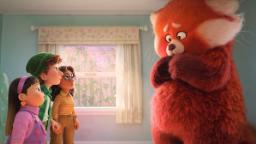
(CNN)In an early scene from the new Pixar film Turning Red, the character Mei is hiding in the bathroom one morning before school. After a particularly embarrassing encounter the night before, she woke up to find herself transformed into a giant red panda.
Mei’s mother Ming reckons this reluctance to leave the bathroom means her 13-year-old daughter just got her first period.
“Did the…did the red peony bloom?” her mother asks through the door.
Soon Ming storms in with ibuprofen, vitamins, a hot water bottle and pads. Mei, unable to tell her mother what’s really going on, endures an awkward conversation about how she’s now a woman and how her body is beginning to change.
Mei is indeed going through a physical transformation – just not the one her mother thinks she is. As Mei soon finds out, she transforms into a furry red panda when overwhelmed by emotions and only returns once she has her emotions under control. Menstruation might not be what makes Mei ill, but the metaphor for periods, puberty, and the emotional rollercoaster that follows is clear.
By normalizing — and even celebrating — one of life’s most uncomfortable periods, “Turning Red” does something not often seen in film and television, especially media aimed at children. It treats periods and female puberty as something to embrace rather than be ashamed of.
‘Turning Red’ normalizes periods
Although half of the world’s population spends a significant part of their lives dealing with menstruation, they are often viewed on screen (if at all) with fear, shame or disgust. It’s a taboo director Domee Shi was well aware of.
“You don’t see that very often in movies and TV shows,” Shi said of the conversation between Mei and her mother in an interview with entertainment news site Uproxx. “And I think that’s exactly why we wanted to put it in the film. I mean, this movie is actually for 13-year-old Domee, who was horrified in a bathroom and thought she wet her pants. And too scared to tell her mom or ask anyone what was going on.”
While positive period depictions are rare in children- and family-oriented films and television shows, there are some notable examples. On a 1990 episode of The Cosby Show when Rudy gets her first period, the youngest Huxtable rebuffs her mother Clair Huxtable’s efforts to celebrate the occasion and enlists the support of her friends. When the information she’s getting from her friends is inaccurate, Clair steps in to reassure her that her period is perfectly normal.
There was the 1991 episode of the sitcom Blossom, in which the title character had trouble talking to her father about her first period and wished she had Clair Huxtable to guide her. In a scene from the 1991 coming-of-age film My Girl, Vada screams that she’s bleeding, only to be told she’s got her period. In a 2001 episode of the animated series Braceface, Sharon mistook her menstrual cramps for appendicitis. And more recently, the ABC sitcom Black-ish treats Diane’s first period as an empowering experience.
However, these examples are the exception rather than the rule. Tackling the period theme feels particularly radical for an animation giant like Pixar, considering that 20 of the 24 films released by the Studio Center are male. But by addressing menstruation with openness and levity, the creators of Turning Red aim to destigmatize it — for everyone, not just young girls.
“The hope is to get it on screen and have something that’s crumbly but also funny, and part of that story, it normalizes it,” producer Lindsey Collins told pop culture and gaming news site Polygon. “Everyone who’s been through it appreciates what we brought to screen, but so are those who haven’t been through it.”
It also encompasses the emotional extremes of puberty
Beyond Periods, Turning Red explores puberty in all its uncomfortable glory through the eyes of a confident, goofy Chinese-Canadian girl. In the words of Shi, it’s an “Asian tween fever dream”.
Throughout the film, Mei navigates the awkwardness, excitement, and embarrassment that come with changing hormone levels, manifesting in her body as a red panda. Struggling with lust and attraction, she develops a crush on a teenage grocery store cashier and members of her favorite boy band, 4*Town, in equal measure. She imagines her objects of desire as mermen and berates herself for it when her drawings are discovered. She longs to see 4*Town with her best friends and lashes out at them in anger when her mother says no.
“From the beginning, [I was] I’m just really trying not to hold back when I tell the story about a girl going through puberty. We will go there,” Shi said in an interview with IndieWire. “From the very first version, it had pads, it had puberty, it had the odd boy crushes and drawings.”
But perhaps Mei’s biggest challenge at this time in her life is figuring out how to be herself while respecting her parents’ wishes — a coming-of-age dilemma surely familiar to many immigrant children. As Mei finds out more about who she is, she realizes that parts of herself are at odds with the image her mother has of her. Learning to accept these parts of herself while finding the courage to stand up to her mother is also part of Mei’s pubertal transformation.
Shi said she hopes “Turning Red” will help girls and women feel seen – and that it will signal that periods, puberty and unruly emotions are just a normal part of life.
Add Comment